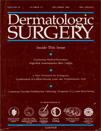Benign Familial Pemphigus (Hailey-Hailey Disease)
Treatment with the Pulsed Carbon Dioxide Laser
Abstract
background
Benign familial pemphigus (BFP) is a chronic blistering disease with significant morbidity. Surgical methods are often needed to control flares in difficult cases.
objective
To describe the response of BFP to vaporization with a pulsed carbon dioxide (CO2) laser.
methods
A 38-year-old woman with chest and axillary involvement unresponsive to conventional therapy was treated with the UltraPulse 5000 Laser (Coherent Medical Group, Palo Alto, CA). After active sites of BFP showed good response to treatment, we treated uninvolved skin of the left axilla to assess the efficacy of prophylactic therapy.
results
Treatment of affected areas, except biopsy sites, resulted in clearing of active lesions after 1–2 weeks. We noted striking sparing of the treated areas from developing subsequent disease. The region that was later treated prophylactically has shown minor, asymptomatic recurrence of BFP in less than 5% of the area treated over an 18-month follow-up period.
conclusion
The pulsed carbon dioxide laser is a useful modality in treatment of BFP. In our patient, prophylactic treatment led to near complete eradication of disease in the treated area. A controlled, larger study is needed to confirm our results, and to determine optimal laser parameters. Long-term effects and duration of remission remain to be determined.




